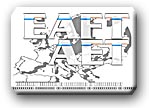Conférence
pour une
infrastructure
terminologique en Europe
Conferencia para una infraestructura terminol�gica en Europa
Conference
for a terminology
infrastructure in Europe
Paris,
13-14-15/03/2000
Maison de l'UNESCO, Salle XI
7, place de Fontenoy
75007 PARIS
|
.Alastair
Macphail
.
|
Creation of a single interactive terminology database
for the organisations of the European Union
Problem
At present each EU organisation has its own terminology facilities. The three main institutions (European Parliament, European Commission and European Council) have their own on-line databases (EUTERPE, EURODICAUTOM and TIS). The smaller organisations (European Court of Justice, European Court of Auditors, European Investment Bank, European Central Bank, CEDEFOP, CdT) have smaller databases, generally in MultiTerm format or make do with glossaries in word processor format. Some institutions (Economic and Social Committee) have no organised terminology facilities. The creation of the decentralised agencies (OHIM, EMEA, EEA, etc.) has led to the emergence of EU organisations with specific terminology needs, but no infrastructure or in-house linguistic staff to meet them. Furthermore, in the major databases, direct write access for adding or updating information is either impossible or restricted to limited groups of accredited terminologists.
The result of this state of affairs is:
· Duplication and inconsistency of information between databases
· Duplication of effort in collecting and maintaining redundant information
· Waste of resources in developing and maintaining parallel infrastructures
· Time-wasting and loss of information to users through the lack of single access to EU terminology
· Long delay between the appearance of a term in the "real world" and its inclusion in a generally accessible database
· Loss of information through lack of feedback from users
· Emergence of conflicting terminology between institutions
Solution
The EU institutions have for many years been discussing the possibility of setting up a single terminology database for all the EU organisations. This came to a head in May 1998, when the institutions entrusted the CdT with the task of commissioning a feasibility study, which was conducted by Brussels IT consultants Atos S.A. under the leadership of Mr Jean-Luc Vidick and Ms Cristine Defrise of the Université Libre de Bruxelles. The study concluded that a single database was both desirable and feasible and should moreover be interactive in order to harness the expert knowledge of its users (for the most part translators) through their spontaneous input and minimise the delay in the appearance of information in the database.
Acting on these recommendations, the Translation Centre applied for project funding under the IDA (Interchange of data between administrations) programme managed by the Commission's DG Enterprise (ex DG III). In July 1999, DG Enterprise launched a call for tenders on behalf of the CdT to recruit a contractor to carry out the necessary analysis, design and development work. The contract was awarded to a Greek IT firm, Quality and Reliability, in combination with the Danish research institute Center for Sprogteknologi (CST). Work will start on the project at the beginning of 2000. It is intended that the system will be up and running on a pilot basis by end 2000 and will be in full production with public access via the WWW by the second half of 2001.
The system is conceived on the basis of interactive input and updating by users and distributed validation and data management by terminologists. The core of the system will be a single relational database combined with a full-text search engine for speed of consultation. Access will be via a web interfaces. Users will have access rights ranging from read-only consultation for the general public, controlled write access for staff of participating organisations and full write access for data managers. A key aspect of the system is the implementation of a sophisticated and flexible validation workflow. At the user end, there will be a review cycle enabling the individual user to route new information (new entries, additions or changes to existing entries) to a specific user or users (colleagues or a local terminologist) for checking before it is released into the database. Once released into the database, new information will be checked from a formal point of view (conformity with writing rules, correct classification) before being routed to a validator or series validators responsible for checking, validating and completing terminology entries in the specific domain and language combination. The system will be designed so that validation and data management functions can be distributed among the participating institutions.
The aim is to open the database as widely as possible to spontaneous contributions and feedback from users while maintaining control of the quality of the content through tightly managed ex-post checking and validation procedures.

